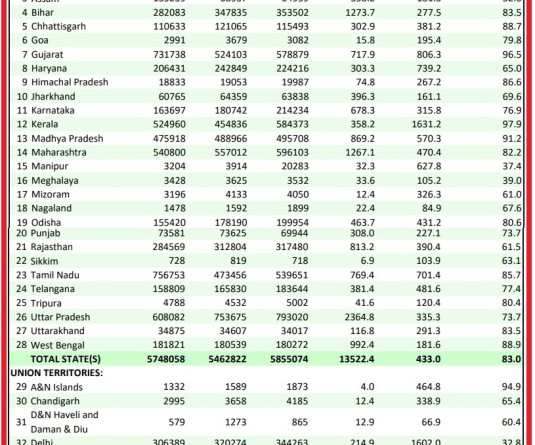
Our Correspondent
Kohima | January 15
Help Nagaland Breathe (HNB), a voluntary response team, today shared its report on activities conducted in response to the COVID-19 pandemic in Nagaland, on the conclusion of its campaign.
Releasing the report at the press conference at Alder Retreat, Kohima today, the team said that the COVID-19 has fundamentally altered lives.
“In Nagaland, we have lost the lives of so many near and dear ones. Although the number of COVID-19 cases and the fatalities might be low compared to other states in India, the looming shocks of the pandemic will continue to impact Nagaland health system which could turn into a social and economic emergency,” the report stated.
In April 2021, HNB, a COVID-19 Campaign, voluntary response team was launched. It eventually assessed that the healthcare system in Nagaland needed greater capacities for testing, protecting and treating.
“Without any mitigation the local health care capabilities will be vastly overwhelmed by the COVID-19 wave. So, together with a few friends, we wanted to help the health care centers and support the ongoing works by the government, churches, aid agencies, NGOs and international organizations,” the report said.
What started as a one-off relief drive resulted in receiving support from 15+ donors from India and overseas, 35+ volunteers based out of India, United States, UK, Ireland, Spain and Vietnam and medical supplies distributed to Nagaland District Hospitals, CIHSR, NHAK, CHCs, PHCs in all the 12 districts of Nagaland.
HNB’s work was amplified through key partner engagements and donors from grassroots to global levels.
Pro-Rural managed all incoming finances for Help Nagaland Breathe and YouthNet supported the ground logistics in Nagaland. Other supporters included Global Shapers Seattle Hub, Kohima Hub, Goonj, New Delhi and India Covid SOS, USA.
HNB functioned from May to November 2021. From fundraising, financial management, ensuring legal compliances to conducting research and monitoring the supply chain of all medical supplies, the teams streamlined all the work virtually across different time zones.
“We share this report to acknowledge all our donors and our partners, the immense contributions made to the people of Nagaland, to track the medical supplies sent to each health center in Nagaland, to celebrate the contributors of our Milaap fundraising campaign and for the volunteers, for the hours spent in this voluntary relief drive. We share our working structures and functions with the hope that this could help other humanitarian and volunteer groups,” stated HNB core member Limabenla Jamir.
Nagaland experienced ‘tough times’
The HNB report stated that much like the rest of the world, Nagaland is still experiencing tough times as a result of the COVID-19 pandemic.
The first two waves approached gradually but had a catastrophic impact on the lives of the people, threatening livelihoods and bringing the state to its knees with the limited resources and manpower to manage this health emergency, it said.
The challenging context, given its geographical location, sparse and scattered population, and the unavailability of required infrastructure made it an even more complex situation as the pandemic spread swiftly across the state.
At the end of the first wave, Nagaland saw over 12,000 positive cases with 78 deaths, with a death rate go 0.65%.
While this number may appear to be relatively less compared to other states in the country, the context of the region makes it significant as it became a question of accessibility and preparedness to deal with this, the report pointed out.
It informed that as essential equipments like Oxygen Concentrators, PPE kits, Oxygen cylinders, and medicines continued to deplete, the desperation, for health care workers and citizens alike, continued to increase with the fear of an imminent second wave.
The HNB team said that the second wave devastatingly scoured through India becoming one of the worst affected in the world, even with vaccinations underway. Health care systems were overwhelmed and the number of deaths only kept spiking as the weeks passed by.
It was not long before the wave reached far and wide into Nagaland, posing, yet again, an indomitable threat as the state was still grappling with the after effects of the first wave. By the end of the second wave, Nagaland saw cases going up to over 32,000 and over 700 deaths, reaching the rural villages where access to proper COVID-19 care was several hours away, it stated.
In the period between the first and the second waves, HNB was formed as a collective of young Naga professionals and students from across the world to help fill the gaps in healthcare delivery systems as the threat of the second wave began to loom over the state.
Pooling in resources from a wider network of individuals, organizations, philanthropies, and foundations working in COVID-19 relief in other parts of the country and abroad, Help Nagaland Breathe was able to provide assistance through medical supplies to all districts with support from the state and district administration.
In its yearlong campaign, HNB said that it has achieved more than what it had initially imagined, reaching out to the most needy and strengthening health care facilities with the necessary equipment to deal with first-response emergency situations.
The team was supported by other groups working for COVID-19 relief, well-wishers, International humanitarian assistance organizations, and local NGOs.
It helped Nagaland COVID-19 Care centers by providing the necessary equipment and aid to mitigate the impact of the pandemic in Nagaland.
The campaign’s efforts included procurement and distribution of medical supplies including but not limited to - Home-care kits, oxygen concentrators, BIPAPS/CPAPS, oxygen cylinders, pulse oximeters, PPE kits.
These were distributed via three channels- directly to verified hospitals, government and through verified on ground NGOs,
Humanitarian Aid - Food supplies support via verified NGOs for families under the poverty line that have been affected by the COVID crisis and loss of primary breadwinners was another area of focus, along with providing meals and ration kits to needy families.




